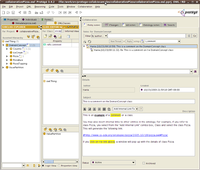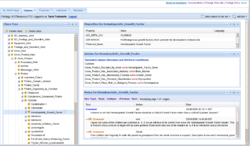Difference between revisions of "CollabProtege Tutorial 2009 Conference"
(New page: Collaborative Protege Tutorial) |
|||
| (6 intermediate revisions by the same user not shown) | |||
| Line 1: | Line 1: | ||
| − | Collaborative Protege Tutorial | + | = Collaborative Ontology Development with Protege = |
| + | - ''Tutorial at the Protege 2009 Conference'' - | ||
| + | |||
| + | {| border="0" width="100%" class="wikitable" | ||
| + | |- | ||
| + | | width="60%" | __TOC__ | ||
| + | | [[Image:CollabProtege_entityNotes.png|200px]] | ||
| + | | [[Image:Webprotege-nci.png|250px]] | ||
| + | |} | ||
| + | |||
| + | |||
| + | == Description == | ||
| + | |||
| + | In recent years, collaborative ontology development has become one of the 'hot topics' in the ontology and Semantic Web communities. [http://protege.stanford.edu/ Protege 3.4.x] already provides features that allow people in a community to edit simultaneously an ontology, to discuss about the ontology content and to document these discussions in the context of the ontology. Users are also able to start change proposals, to vote, to browse and to discuss the change history of an ontology component. Other features include a chat, filtering and search of the discussions in the ontology. A user may edit the ontology either in the [[Collaborative_Protege|Collaborative Protege]] client - an extension of the Protege rich application, or in [[WebProtege]] - a web-based and lightweight ontology editor. | ||
| + | |||
| + | In this hands-on tutorial, you will learn how to set up and use the Protege collaborative environment. We will start by setting up a Protege server, creating users, configuring the projects and their access policies. Then we will learn how to set up a project for collaboration and how to create the changes and annotation ontology. We will also cover partially the set-up of WebProtege. | ||
| + | |||
| + | In the second part of the tutorial, we will split in small groups and we will edit collaboratively an ontology using Collaborative Protege and WebProtege. During this exercise, you will learn how to create different types of notes attached to a particular class in the ontology, how to browse the change history and to comment on it, how to use the chat, and many other tips and tricks. We will also cover all the other features of the collaborative environment. You will also learn how to configure WebProtege, how to layout the portlets to suit different user expertise levels and needs. | ||
| + | |||
| + | If you plan to follow the hands-on portion of the tutorial, basic experience with navigating the Protégé user interface will be assumed. Attendees should know how to perform rudimentary tasks such as opening projects and creating new classes, slots, and instances. | ||
| + | |||
| + | |||
| + | == Preparation == | ||
| + | |||
| + | If you would like to follow the hands-on part of the tutorial, please install the latest version of [http://protege.stanford.edu/ Protege 3.4.x] available on the [http://protege.stanford.edu/download/download.html download website]. | ||
| + | |||
| + | Optional: | ||
| + | If you plan to use WebProtege, all you need is a web browser, such as Firefox, Safari or Internet Explorer. If you want to learn how to setup the WebProtege on a web server, then please read download the latest [[WebProtegeAdminGuide|WebProtege war file]] and read the [[WebProtegeAdminGuide|installation instructions]]. You will also need to have [http://tomcat.apache.org/ Tomcat] or other webserver installed on your computer. | ||
| + | |||
| + | |||
| + | == Instructors == | ||
| + | |||
| + | * [http://bmir.stanford.edu/people/view.php/tania_tudorache Tania Tudorache] | ||
| + | * [http://bmir.stanford.edu/people/view.php/jennifer_l_vendetti Jennifer Vendetti] | ||
| + | * [http://www.stanford.edu/~natalya/ Natasha Noy] | ||
| + | * [http://bmir.stanford.edu/people/view.php/timothy_redmond Timothy Redmond] | ||
| + | |||
| + | |||
| + | == Resources == | ||
| + | |||
| + | For more information, please see the following links: | ||
| + | |||
| + | # [[Collaborative_Protege|Collaborative Protege user guide]] | ||
| + | # [[Protege_Client-Server_Tutorial|Protege Client-Server Tutorial]] | ||
| + | # [http://bmir.stanford.edu/publications/view.php/supporting_collaborative_ontology_development_in_protege ISWC 2008 Paper about Collaborative Protege] | ||
| + | # [http://protege.stanford.edu/doc/users.html Protege user guides] | ||
Latest revision as of 21:54, March 12, 2009
Collaborative Ontology Development with Protege
- Tutorial at the Protege 2009 Conference -

|

|
Description
In recent years, collaborative ontology development has become one of the 'hot topics' in the ontology and Semantic Web communities. Protege 3.4.x already provides features that allow people in a community to edit simultaneously an ontology, to discuss about the ontology content and to document these discussions in the context of the ontology. Users are also able to start change proposals, to vote, to browse and to discuss the change history of an ontology component. Other features include a chat, filtering and search of the discussions in the ontology. A user may edit the ontology either in the Collaborative Protege client - an extension of the Protege rich application, or in WebProtege - a web-based and lightweight ontology editor.
In this hands-on tutorial, you will learn how to set up and use the Protege collaborative environment. We will start by setting up a Protege server, creating users, configuring the projects and their access policies. Then we will learn how to set up a project for collaboration and how to create the changes and annotation ontology. We will also cover partially the set-up of WebProtege.
In the second part of the tutorial, we will split in small groups and we will edit collaboratively an ontology using Collaborative Protege and WebProtege. During this exercise, you will learn how to create different types of notes attached to a particular class in the ontology, how to browse the change history and to comment on it, how to use the chat, and many other tips and tricks. We will also cover all the other features of the collaborative environment. You will also learn how to configure WebProtege, how to layout the portlets to suit different user expertise levels and needs.
If you plan to follow the hands-on portion of the tutorial, basic experience with navigating the Protégé user interface will be assumed. Attendees should know how to perform rudimentary tasks such as opening projects and creating new classes, slots, and instances.
Preparation
If you would like to follow the hands-on part of the tutorial, please install the latest version of Protege 3.4.x available on the download website.
Optional: If you plan to use WebProtege, all you need is a web browser, such as Firefox, Safari or Internet Explorer. If you want to learn how to setup the WebProtege on a web server, then please read download the latest WebProtege war file and read the installation instructions. You will also need to have Tomcat or other webserver installed on your computer.
Instructors
Resources
For more information, please see the following links: